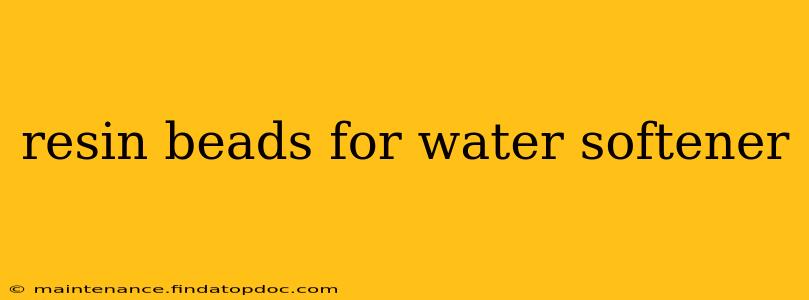Water softeners are essential appliances for many households, removing hardness minerals like calcium and magnesium from water. At the heart of every water softener lies a crucial component: resin beads. These tiny beads are the workhorses, performing the ion-exchange process that makes hard water soft. This comprehensive guide dives deep into the world of resin beads, explaining their function, types, lifespan, and more.
What are Resin Beads?
Resin beads are small, spherical particles made of a synthetic polymer resin. These beads are specifically designed with negatively charged sites that attract positively charged ions, primarily calcium (Ca²⁺) and magnesium (Mg²⁺), which cause water hardness. During the softening process, these hardness minerals are exchanged for sodium (Na⁺) ions, resulting in softer water.
How Do Resin Beads Work?
The process is called ion exchange. As hard water flows through the resin bed (a tank filled with resin beads), the calcium and magnesium ions bind to the negatively charged sites on the resin beads, releasing sodium ions into the water. This exchange continues until the resin beads become saturated with calcium and magnesium ions, a point called the exhaustion of the resin. At this point, the softener needs to be regenerated.
Types of Resin Beads
While the core function remains the same, there are different types of resin beads, each with varying characteristics:
-
Gel Resin: This is the most common type, known for its high capacity and relatively low cost. Gel resin beads are dense and have a smaller surface area compared to macroporous resins.
-
Macroporous Resin: This type features a more porous structure, making it less prone to fouling from organic matter. While offering better resistance to organic contaminants, they typically have a slightly lower capacity than gel resins.
-
Strong Acid Cation Resin: This is the standard resin used in most water softeners, as it effectively removes a wide range of hardness minerals.
How Long Do Resin Beads Last?
The lifespan of resin beads typically ranges from 8-12 years, but this can vary depending on several factors:
- Water Quality: Higher levels of hardness minerals and contaminants can shorten the lifespan.
- Usage: Frequent use naturally leads to faster exhaustion and quicker depletion of the resin's capacity.
- Maintenance: Proper regeneration and maintenance significantly extend the lifespan.
- Resin Type: Different resin types have varying durability levels.
How Often Should I Replace My Resin Beads?
You should consult your water softener's manual for guidance on resin replacement frequency. Regular monitoring of water hardness levels and softener performance will indicate when replacement becomes necessary. Signs of needing resin replacement include noticeably hard water despite regeneration, frequent regeneration cycles, and reduced water flow.
Regenerating Resin Beads
Regeneration is a crucial process that restores the ion-exchange capacity of the resin beads. This typically involves backwashing the resin bed to remove accumulated debris, followed by a brine solution (highly concentrated salt water) which displaces the accumulated hardness minerals from the beads, releasing them into the drain.
What are the Different Sizes of Resin Beads?
Resin beads are typically available in various sizes, although the exact specifications depend on the manufacturer. The size directly impacts the flow rate and efficiency of the water softener. While exact measurements aren't typically advertised to the consumer, smaller beads generally provide higher surface areas but also slightly higher pressure drop (more resistance to water flow)
Can I Clean My Resin Beads?
While you can't clean the resin beads directly, the regeneration process helps to maintain their effectiveness by flushing out accumulated contaminants. However, if the resin becomes heavily fouled due to high levels of organic matter, replacement might be necessary.
Are Resin Beads Safe?
Yes, the resin beads used in water softeners are generally safe for human consumption. The sodium released into the water during the softening process is in small amounts and poses no significant health risk for most people. However, individuals on low-sodium diets might want to consider this.
This comprehensive guide provides a thorough understanding of resin beads used in water softeners. Remember, regular maintenance and monitoring are crucial for optimal performance and longevity. Consult your water softener manual or a qualified professional for specific recommendations regarding your system.
